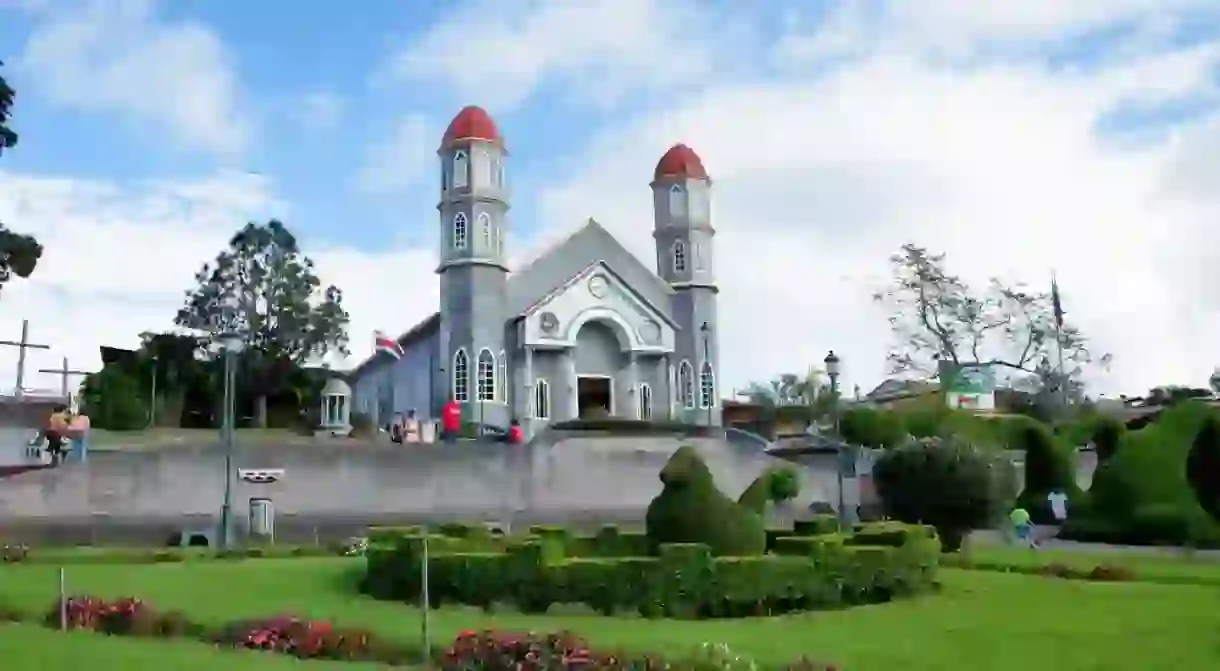The Most Beautiful Churches to Visit in the Central Valley of Costa Rica

The national religion of Costa Rica is Roman Catholicism. Over 76% of Costa Ricans identify as Roman Catholic, but only around 45% are truly devout. The other 31% usually just attend mass on important religious holidays and for weddings and baptisms. The next predominant religious denomination is Evangelical Christianity, followed by the Jehovah’s Witnesses, Mormonism, Judaism, and Islam. Every town has a Catholic Church, though, and some of the most beautiful ones are in the central region of Costa Rica.
Basílica de Nuestra Señora de los Ángeles
Cathedral

The Basílica de Nuestra Señora de los Ángeles is Cartago’s most important religious monument and cathedral. This ornate Byzantine-inspired basílica is complete with exquisite stained-glass windows, hand-painted interiors, and beautifully carved wooden alters. It is also the home of La Negrita, a relic that thousands of Costa Ricans from around the country come to pray to every year on August 2.
Iglesia de Nuestra Señora de las Mercedes
Cathedral

The Iglesia de Nuestra Señora de las Mercedes is an iconic church in Costa Rica and the centerpiece of the charming and picturesque town of Grecia. The church was constructed out of prefabricated steel sheets that came all the way from Belgium. There were many theories once tossed around as to why metal sheets from Belgium ended up all the way in Costa Rica to build a church in a small town in the Central Valley. The truth became known that the government and local investors, including a wealthy coffee exporter, made the decision to purchase and construct this marvelous metal church. Aside from being built entirely out of metal, it was also painted red. This lovely cathedral is really a sight to see and the pride of Grecia.
Iglesia de San José de Orosi
Cathedral

Orosi is an inviting and peaceful mountain town just 35 kilometers (22 miles) outside of San José. This hidden gem is reputed to have the most pleasant climate in all of Costa Rica and some of the richest soil, which is why some believe the best coffee also comes from here. The Igelsia de San José de Orosi is Costa Rica’s oldest church that is still in full use today. This charming historic church was inspired by classic Spanish-colonial architecture. There is also a small museum attached to the church that has some interesting art and artifacts, as well as a beautiful garden.
Catedral Metropolitana
Church, Park

Iglesia de Coronado
Cathedral

The design of the Iglesia de Coronado was influenced by French and German gothic architecture style. Located in the city of Coronado, just outside of San José, this important religious landmark was built back in the 1880s and has since been repaired multiple times due to earthquake damage. During certain times of the year, you can actually climb up the clock tower of the church where you will be rewarded with one of the most magnificent views of the city.
Iglesia de San Rafael
Cathedral

The Iglesia de San Rafael (sometimes called Parroquía de San Rafael Arcángel) in the quaint town of Zarcero is an exquisite place of worship. It is also sometimes called the blue and pink church for reasons that will become obvious when you are there in person. From the outside it appears that it is constructed out of brick and marble, but it is actually built from steel. The interior is masterfully painted and accentuated with intricate stained-glass windows. This church has a lot of character and charm and is definitely worth a visit when you are exploring the picturesque town of Zarcero.
Iglesia de Cañas
Cathedral

La Iglesia de Cañas is technically outside of the Central Valley, but far enough inland in Guanacaste that it should definitely be on the map of the most beautiful churches in the central part of Costa Rica. Otto Apuy, one of the most recognized and revered modern artists in Costa Rica, designed and covered the entire church in colorful mosaic tiles. The center tower of the church, which is 30 meters (98 feet) tall, is entirely enveloped in mosaic art. There are religiously themed mosaic murals and also vibrant abstracts. It has been estimated that over a million kaleidoscopic tiles cover the facade of the Iglesia de Cañas.













